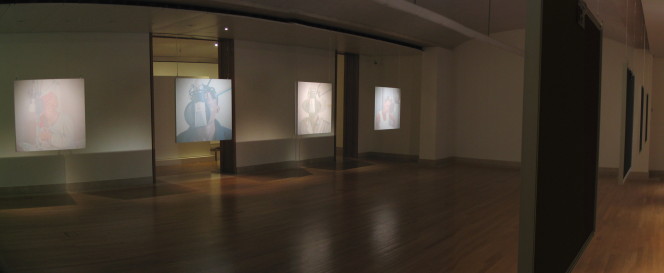![]()

HEARING VOICES
Brunei Gallery, London
By Clive Bell
John Wynne has created a gallery installation by recording the voices of eight speakers of click-languages in the Kalahari Desert in Botswana. The listener is surrounded by eight large portraits of the speakers, each one a photograph suspended in midair, of a person talking very close to a chunky studio microphone. Faces are partly obscured by the mic, and Wynne makes no bones about the vast technological and cultural gap between their world and ours. But photographer Denise Hawrysio's portraits are also the loudspeakers through which we hear Wynne's music. Sound shifts around the room and each portrait, as in a fairytale, takes its turn at speaking to us.
The click-languages themselves are dizzying in their strangeness and variety. Each sentence, though softly spoken, detonates and fizzes with tiny aural explosions made from every part of the palate or throat. "I personally feel inferior to someone who can produce 80 different click sounds," quips a Westerner in Wynne's radio version of the piece. But Wynne underlines the fragility of these endangered languages by only giving occasional glimpses of actual words. The rest of the time we stand amidst a soundscape that he has created from the voices' raw material: clicks are processed to generate bell tones, while vowels are massively extended into shimmering drones. The result is an ambient music, calm and beautiful, in which we have space to think about the issues underlying the piece; but it's also a shimmering, ominous sound which conjures the desert itself. This is impressive sound sculpture, in the sense of moulding something new from the plastic sonic material. By reading the translations of what the speakers say we get a sense of their lives - displacement, poverty, alcohol, road accidents, storytelling - but the visual information provided is minimal so we focus firmly on the sound itself.
Wynne has also presented his Botswana material as a "composed documentary" for BBC Radio 3. Here there is a nice tension between everyday village sounds (cocks crow and children call behind a speaking voice) and the musical heat curtain, like a choir of insects, that Wynne has created by processing vocal clicks. His music is strong enough to stand on its own feet even without its context; but the knowledge that it's all been high-tech assembled from the speech of Africans living in one of the most deprived regions on earth gives it an ambivalent, yet almost magical tinge. Then there's a CD-ROM accompanying the gallery show, where a deal of information about the languages ic clearly laid out, and we get to hear the Bokamoso Pre-school Training Project Choir. Their swaying Christian harmonies seem to be driven by handclaps - but no, it's those clicks again.